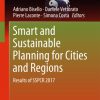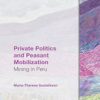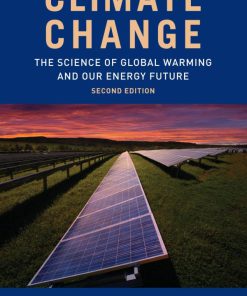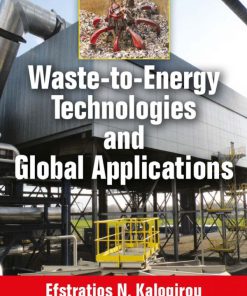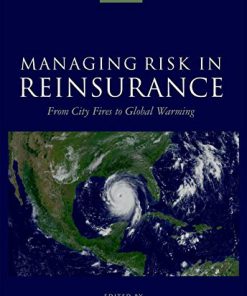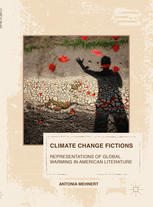Energy Solutions to Combat Global Warming 1st edition by XinRong Zhang 9783319269504 331926950X
$50.00 Original price was: $50.00.$25.00Current price is: $25.00.
Energy Solutions to Combat Global Warming 1st edition by XinRong Zhang – Ebook PDF Instant Download/Delivery: 9783319269504, 331926950X
Full download Energy Solutions to Combat Global Warming 1st edition after payment
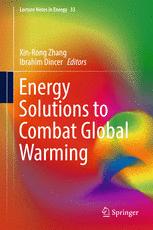
Product details:
• ISBN 10:331926950X
• ISBN 13:9783319269504
• Author: XinRong Zhang
Energy Solutions to Combat Global Warming
This book gathers an in-depth collection of 45 selected papers presented at the Global Conference on Global Warming 2014 in Beijing, China, covering a broad variety of topics from the main principles of thermodynamics and their role in design, analysis, and the improvements in performance of energy systems to the potential impact of global warming on human health and wellbeing. Given energy production’s role in contributing to global warming and climate change, this work provides solutions to global warming from the point of view of energy. Incorporating multi-disciplinary expertise and approaches, it provides a platform for the analysis of new developments in the area of global warming and climate change, as well as potential energy solutions including renewable energy, energy efficiency, energy storage, hydrogen production, CO2 capture and environmental impact assessment. The research and analysis presented herein will benefit international scientists, researchers, engineers, policymakers and all others with an interest in global warming and its potential solutions.
Energy Solutions to Combat Global Warming 1st Table of contents:
1 Development of Supercritical CO2 Solar Rankine Cycle System
Abstract
1 Introduction
2 Outline of Supercritical CO2 Solar Rankine Cycle System
3 Experimental Setup
3.1 Evacuated Tube Solar Collector
3.2 Turbine
3.3 Heat Exchanger
3.4 Mechanical Feed Pump
4 Representative Characteristics of Original System
4.1 Economic Aspect
5 Development of Key Elements in Supercritical CO2 Solar Rankine Cycle System
5.1 The Investigation on Evacuated Tube Solar Collector
5.2 New Design Aspect for Supercritical CO2 Turbine
5.3 Construction of Novel Thermally Driven Pump
6 Summary
Acknowledgments
References
2 Study on the Solar Energy Heat Pump Space Heating System in the Agricultural and Pastoral Areas in
Abstract
1 Introduction
2 Investigations on the Space Heating Conditions in the Agricultural and Pastoral Area
2.1 Space Heating Energy Sources
2.2 Space Heating Devices
2.3 Discussions on the Results of the Investigations
3 The Solar Energy Heat Pump Space Heating System
3.1 The Application of the Solar Energy Heat Pump Space Heating System in the Agricultural and Pasto
3.2 The Principle of the Solar Energy Heat Pump Space Heating System
3.3 Operating Modes of the Solar Energy Heat Pump Space Heating System
4 Discussions on the Economic Benefits, Social Benefits, and Environmental Benefits of the Solar Ene
4.1 Economic Benefits Analysis
4.2 Social Benefits Analysis
4.3 Environmental Benefits Analysis
5 Conclusions
Acknowledgments
References
3 LNG Cold Energy Utilization Technology
Abstract
1 Introduction
2 Cold Exergy in LNG
3 LNG Cold Energy Utilization
3.1 Power Generation
3.2 Air Separation
3.3 Liquid CO2 and Dry Ice Production
3.4 Cold Storage and Rapid Cooling
3.5 District Cooling
4 Case Study: Cold Energy Utilization in LNG Carrier
5 Conclusions
Acknowledgments
References
4 Cold Thermal Energy Storage Materials and Applications Toward Sustainability
Abstract
1 Introduction
2 Cold Thermal Energy Storage Materials
2.1 Sensible TES
2.1.1 Chilled Water
2.1.2 Water Stratification Enhancements
2.2 Latent TES
2.2.1 Selection Criteria for PCMs and PCM Slurries
2.2.2 Ice/Ice Slurries and Ice-Making System
2.2.3 Material Selection and Property Improvement for Above-Zero Applications
Salt Hydrates and Eutectics
Paraffin Waxes and Fatty Acids
Refrigerant Hydrates
Other PCMs or PCM Slurries
2.2.4 Material Selection and Property Improvement for Subzero Applications
Eutectic Water-Salt Solutions
Non Eutectic Water-Salt Solution PCMs
Other PCMs or PCM Slurries
2.3 Sorption Cold Storage
2.3.1 Absorption TES
Working Principle
Working Pair Selection
Heat Transfer and System Performance Enhancement
2.3.2 Adsorption TES
Working Principle
Working Pair Selection
Heat Transfer and System Performance Enhancement
3 Cold Thermal Energy Storage Applications for a Sustainable Future
3.1 Building Air Conditioning Application
3.2 Building Construction Unit Integration Application
3.3 Food Storage and Transport and Ice-Making Application
3.4 Vehicle System Thermal Comfort Application
4 Conclusions
Acknowledgments
References
5 Economic Analysis of LNG Cold Energy Utilization
Abstract
1 Introduction
1.1 The Necessity of Cold Energy Utilization
1.2 Analyze on Cold Energy Utilization Status
1.2.1 Technology Analysis on Cold Energy Utilization
1.2.2 The International Cold Energy Utilization Status Analysis
1.2.3 China Cold Energy Utilization Analysis
2 Economic Benefit Analysis of Cold Energy Utilization
2.1 Economic Analysis on International Cold Energy Utilization
2.2 Economic Benefit Analysis of China Cold Energy Utilization
2.2.1 Cold Energy Air Separation
2.2.2 Rubber Crush
2.2.3 Butyl Rubber
2.3 Restricting Factors on Economic Benefits
3 Social Benefit Analysis of Cold Energy Utilization
4 Macro-economic Analysis of Cold Energy Utilization
5 Discussion
6 Conclusions
References
6 Zeotropic Mixture and Organic Ranking Cycle
1 Scope
2 Zeotropic Mixture
2.1 Zeotropic Mixture Selection
2.2 Phase Change with Temperature Glide
2.3 Composition Shift
2.4 Influence of Composition on ORC System
3 Expander
4 Solar Driven ORC
4.1 Thermodynamic Relationships in the Solar ORC
4.2 Solar Collector
4.3 ORC System with a Recuperator
4.4 ALSRC System
4.5 SOL-ORC-CO2 System
5 Concluding Remarks
References
7 Methane Production from Napier Grass by Co-digestion with Cow Dung
Abstract
1 Introduction
2 Materials and Methods
3 Results and Discussion
4 Conclusions
Acknowledgments
References
8 Possibilities for Biogas Production from Waste—Potential, Barriers, and Legal Notices
Abstract
1 Introduction
2 Background
2.1 Suitable Biomass for Biogas Production [6, 7]2.2 Legal Framework for the Production and Use of Biogas in Bulgaria
2.3 Main Barriers for Farmers in the Production of Biogas
2.4 Financial Conditions in the Construction of Biogas Plants
2.5 Supporting Mechanisms for Production of Electricity from Renewable Energy Sources (RES)
2.6 Supporting Mechanisms for Heat Production from RES
3 Conclusions
References
9 Research on Tidal Current Energy Converter Using Artificial Muscles and VIV Theory
Abstract
1 Introduction
2 VIV Principle
3 Motion Equations of VIV
4 Numerical Simulation of the Model
5 Dielectric Elastomer (DE) Performance Test
6 Flume Experiments
6.1 Experiment Flume
6.2 The Experiment of Hydrostatic Attenuation
6.3 Running Water Experiment
7 Result Analysis and Discussion
Acknowledgments
References
10 The Energy Capture Efficiency Increased by Choosing the Optimal Layout of Turbines in Tidal Power
Abstract
1 Introduction
2 Related Researches on Wake Effects of Turbines in Multi-arrays
3 Numerical Study on the Interaction Influence in Tidal Arrays by Using CFD
3.1 Introduction to CFD
3.2 Assumed Conditions
3.3 Control Equations
3.4 The Solving Process of Turbine Wake Model
4 Researches on the Interaction Influence in Multi-arrays by Considering the Layout of Tidal Turbine
4.1 Layout of Tidal Power Turbines Array
4.2 Numerical Simulation of Tidal Turbine Layout
4.3 Velocity Interaction Influence Analysis Between Tidal Turbines
5 Researches on the Interaction Influence in Multi-arrays by Considering the Rotation Directions of
5.1 The Axial Thrust Analysis
5.2 Flow Field Analysis
6 Model Test for Tidal Turbines Wake Field in Multi-arrays
6.1 Test Scheme and Design of Interaction Influence Between Turbines in Multi-array
6.2 Related Test Equipment and Model Turbines
6.3 Case of Comparison of Calculating and Testing Results in Multi-arrays
7 Results and Discussion
8 Conclusions and Future Work
Acknowledgments
References
11 Modelling Analysis of the Influence of Wave Farm to Nearshore Hydrodynamics Forces
Abstract
1 Introduction
2 Theories
2.1 Methods of Estimating Wave Energy
2.2 Wave Model Description
2.3 Flow Model Theory
3 Model Setting and Validation
3.1 Model Setting
3.2 Model Validation
4 Wave Energy Resource
5 Analysing of Hydrodynamic Environment Evolution
5.1 Wave Climate
5.2 Wave-Induced Longshore Current
6 Summaries
Acknowledgments
References
Utilization of Waste
12 Energy Saving and Emission Reduction from the Steel Industry: Heat Recovery from High Temperature
Abstract
1 Introduction
2 Properties of the High Temperature Slags
3 Physical Method
3.1 Mechanical Crushing Granulation Method
3.2 Air Blast Granulation Method
3.3 Centrifugal Granulation Method
4 Chemical Method
4.1 Methane Reforming Reaction Method
4.2 Pyrolysis and Gasification Reaction
4.3 Reduction Reaction Method
5 Other Methods of the Heat Recovery from Slags
5.1 Selective Crystalline and Phase Separation Method
5.2 Slag Wool Production Method
5.3 Other Novel Methods
6 Summary and Conclusions
Acknowledgments
References
13 The Feasibility Study on Blast Furnace Low Temperature Heat Source Refrigeration for Dehumidified
Abstract
1 Introduction
2 Hot Blast Stove Gas Refrigeration for Blast Furnace Blowing Dehumidifying System Process
3 The Determination of Reasonable Humidity in Blast Furnace Blowing Dehumidifying System
4 The Analysis of Economic and Energy Saving
5 Conclusions
Acknowledgments
References
14 Sludge Treatment by Low-Temperature Heat
Abstract
1 Introduction
2 Comparison Among Several Low-Temperature Sludge Thermal Treatment Technologies
2.1 Solar Energy Low-Temperature Sludge Thermal Treatment Technology
2.2 Heat Pump Low-Temperature Sludge Thermal Treatment Technology
2.3 Low-Temperature Sludge Vacuum Dehydration Technology
2.4 Waste Heat Utilization Technology in Low-Temperature Sludge Heat Treatment
3 The Main Factors Influencing the Effect of Low-Temperature Sludge Drying
4 Conclusion
Acknowledgments
References
15 Resourceful Treatment of Seawater Desalination or High Concentrated Sewage by Renewable Energy
Abstract
1 Introduction
2 Background
2.1 The Global Water Crisis
2.2 Causes of Water Pollution and Water Scarcity
2.3 Effects of Water Pollution
2.4 Different Types of Water Pollution
2.5 Solutions for Energy and Water Resources
3 Introduction of Solar Energy or Waste Heat and Water Treatment Technology
3.1 Solar Energy
3.2 Waste Heat
3.3 Seawater Desalination
4 Indirect Desalination Systems
4.1 Non-membrane Processes
4.2 Solar Multi Stage flash Desalination
4.3 Solar Multi Effect Distillation
4.4 Vapor Compression Desalination
4.5 Natural Vacuum Desalination Systems
5 Conclusion
Acknowledgments
16 Microbiological Assessment of Sewage Sludge in Terms of Use as a Fertilizer
Abstract
1 Introduction
2 Materials and Methods
3 Results
4 Discussion
5 Conclusions
Acknowledgments
References
17 Establishment of Changes in the System “Soil-Fertilizer-Plant” as a Result of Fertilization w
Abstract
1 Introduction
2 Materials and Methods
3 Results and Discussion
4 Conclusions
Acknowledgments
References
18 Agrochemical and Chemical Assessment of Waste from Livestock Farms
Abstract
1 Introduction
2 Materials and Methods
3 Results and Discussion
4 Conclusions
Acknowledgments
References
Methods and Techniques
19 Super Clean Marine Diesel Engines with Nonthermal Plasma Aftertreatment Technology
Abstract
1 Introduction
2 Principle of the Nonthermal Plasma NOx Aftertreatment
3 Laboratory-Scale NOx Aftertreatment
3.1 Operating Principle and Experimental Apparatus
3.2 Results and Discussion
4 Pilot-Scale NOx Aftertreatment
4.1 Operating Principle and Experimental Apparatus
4.2 Results and Discussion
5 Conclusions
Acknowledgments
References
20 Natural Convection Supercritical Fluid Systems for Geothermal, Heat Transfer, and Energy Conversi
Abstract
1 Supercritical Natural Circulation System and Its Basic Design Challenges
2 Numerical Model for Supercritical NCL
2.1 Formation of Physical Model
2.2 Controlling Equations and Numerical Methods
2.3 Boundary and Initial Conditions
3 Stability Problem for Sup NCL and Numerical Verifications
3.1 Supercritical Stability Behavior
3.2 Effect of Heat Source Temperature
3.3 Effect of Loop Inner Diameter
3.4 Effect of Loop Aspect Ratio
3.5 Effect of Unsteady Heat Input
3.6 Effect of Heater/Cooler Orientation
3.7 Effect of Loop Inclination
4 Discussion on Supercritical Loop Flow Correlations
5 Experiment on Natural Circulation Loops and Its Implications
5.1 Experimental Setups
5.1.1 Apparatus Design
5.1.2 Data Collection and Manipulation
5.1.3 Experimental Procedure
5.2 Basic System Stability Formulation
5.3 Flow Characteristics from the Initial State
5.3.1 Basic Flow Behaviors for Cases with Subcritical Initial States
5.3.2 Comparison of Cases with Different Initial Pressure
5.4 Stability Transition Analysis for Operational Changes
5.4.1 Basic Parameter Analysis
5.4.2 Stability Transitions in the Supercritical Region and Evolution Trend
5.5 Heat Transfer Behaviors
5.5.1 Temperature Behaviors Under Different Operation Pressures
5.5.2 Further Heat Transfer Analysis and Comparisons
6 Design Example on Subcritical-Based Solar Conversion
6.1 Prototype Design
6.1.1 Formation of Model
6.1.2 System Measurement and Operation
6.2 Performance Analysis and Discussion
6.2.1 Basic Condition and Solar Radiation Test
6.2.2 Flow Condition of Supercritical CO2 Collector Side
7 Optimizations and Future Concerns
8 Summary
Acknowledgments
References
21 Numerical Analysis of Air Flow Around a Hot Water Radiator for Its Structure Improvement
Abstract
1 Introduction
2 Description of the Physical Model
3 Simulating Conditions
3.1 Setting of the Solving Model
3.2 Material Properties
3.3 Boundary Conditions
4 Results and Discussion
4.1 Temperature Field
4.2 Velocity Field
5 Structure Optimization
6 Conclusions
References
22 Sustainability Assessment of a Turboprop Engine: Exergy-Based Method
Abstract
1 Introduction
2 Background
2.1 Energy Terms
2.2 Exergy Terms
2.3 Sustainability Terms
3 Case Study
3.1 General Description of the TPE
3.2 Exergy Assessment
3.3 Sustainability Assessment
4 Conclusion
Acknowledgments
References
23 Exergy Approach to Evaluate Performance of a Mini Class Turboprop Engine
Abstract
1 Introduction
2 Thermodynamic Fundamentals
2.1 First Law Approach
2.2 Second Law Approach
2.3 Some Useful Exergy Parameters
3 General Description of the Engine
4 Exergy Analysis of the Mini Class Turboprop Engine
5 Conclusion
Acknowledgments
References
24 The Efficient Use of the Water Resources and the Global Warming: The Case of North Cyprus “Wate
Abstract
1 Introduction: Water Politics in the World and in Turkey
2 Water as a New Parameter of Politics in Cyprus
3 TRNC “Water of Peace Project”
3.1 Design and Engineering
3.2 TRNC ‘Water of Peace Project’ and its Comparative Analysis with the Southeast Anatolia Irrig
4 General Conclusions and Recommendations
References
25 Investigation and Analysis of New Energy Technology Application Status in Beijing—Water Source
Abstract
1 Introduction
2 Water Source Heat Pump Application Status in Beijing
2.1 General is Given Priority to the Underground Water, but a Downward Trend Year-by-Year
2.2 The Soil Source and the Sewage and Reclaimed Water Source Heat Pump System Gradually Developed
2.3 The Area Distribution of Heat Pump Project is Relatively Concentrated
3 Water Source Heat Pump Application Effect Evaluation
3.1 Energy Conservation and Emission Reduction Benefit is Remarkable
3.2 Potential Economic Benefits
3.3 To Promote Clean Energy Use, Improve the Urban Energy Structure
4 The Problems in the Development of Water Source Heat Pump in Beijing
4.1 The Problems of Limit of Utilizable Water Resources Conditions
4.2 Hydrogeological Conditions, Recharge, and Water Pollution Problems
4.3 Water Source Heat Pump Development Policies Need to Be Adjusted
5 Countermeasures and Suggestions for the Developments of Beijing Water Source Heat Pump
5.1 Strengthen the Study of Feasibility of Water Source Heat Pump Project
5.2 Enhance Refilling Technology and Water Processing Skills
5.3 Adjust Measures to Local Conditions, Make Reasonable Layout, and Optimize the Structure of Water
6 Prospect for the Future Development
7 Conclusions
References
26 Analysis of the Thermal Effect About Groundwater Flowing to the Nest of Tubes Heat Transfer
Abstract
1 Introduction
1.1 Mathematical Model in Porous Medium of the Soil Area
2 Mathematical Model of Tube Fluid
2.1 Mesh Generation
3 Analyses of the Simulation Result
3.1 The Influence of Groundwater Seepage on the Heat Exchange of Buried Pipes
3.2 The Change of Soil Temperature Around the Pipes
3.3 The Influence of Groundwater Seepage on the Heat Exchange of Buried Pipe
4 Conclusions
Acknowledgments
References
27 Hydraulic Characteristics of the Francis Turbine with Various Groove Shapes of Draft Tube
Abstract
1 Introduction
2 Numerical Model
3 Grid Systems and Boundary Conditions
4 Governing Equations
5 Results and Discussion
6 Conclusion
References
Energy Storage
28 Progress in Sorption Thermal Energy Storage
Abstract
1 Introduction
2 Sorption TES Concept
2.1 Storage Principle
2.2 Classification
2.3 Comparison of Sorption Refrigeration and TES
3 Material Selection Criteria
4 TES Based on Absorption
4.1 Working Pairs
4.2 Systems
5 TES Based on Adsorption
5.1 Working Pairs
5.2 Systems
6 TES Based on Sorption Reaction and Composite Materials
6.1 Working Pairs
6.2 Systems
7 Conclusions and Outlooks
7.1 Summary of Current Sorption TES Technologies
7.2 Future Developing Roadmaps
Acknowledgments
References
29 Mitigating Global Warming by Thermal Energy Storage
Abstract
1 Background
2 Methods for TES
2.1 Sensible Heat Storage (SHS)
2.2 Latent Heat Storage (LHS)
2.3 Thermochemical Energy Storage
2.4 Comparison of the Three Energy Storage Methods
3 Case Study
3.1 Aquifer Thermal Energy Storage
3.2 Phase Change Material Plates
3.3 Concentrated Solar Power
3.4 Phase Change Slurries
3.5 Thermochemical Heat Storage Prototype
3.6 Summary
4 Conclusions
References
30 Enhance the Wind Power Utilization Rate with Thermal Energy Storage System
Abstract
1 Introduction
2 System Description
3 The Key Technologies
3.1 Thermal Energy Storage
3.2 Combined Heat and Power System
4 Thermal Analysis
4.1 The Basic Calculation Model
4.2 The Pump Power Consumption
4.3 The Heat Transfer Process in the Boiler
4.4 Air Blower Power Consumption
4.5 Cogeneration Process Calculate
4.6 Case Study
5 The Main Advantages
5.1 In Situ Elimination the Surplus Renewable Energy
5.2 Energy Conservation and Emission Reduction
5.3 Enhance the Wind Power Utilization
6 Conclusion
Acknowledgments
References
31 A Review of PCM Energy Storage Technology Used in Buildings for the Global Warming Solution
Abstract
1 Introduction
1.1 Building Energy Efficiency and the Global Warming
1.2 Energy Storage Technology
1.3 Developmental Stages of PCM Using in Buildings
1.4 The Applications of PCM Used in Buildings and Building Systems
2 PCM
2.1 Classification and Characteristic of PCM
2.2 Thermal Properties of Some Potential PCMs
2.3 PCM Selection and Study Methods
3 PCM Used in Building Envelope
3.1 PCM Wall
3.2 PCM Roof
3.3 PCM Floor
3.4 PCM Panel
3.5 PCM in Building Materials
3.5.1 PCM-Modified Mortar
3.5.2 PCM-Concrete
3.5.3 PCM-Gypsum Board
3.6 PCM Window and Sunshade
3.6.1 PCM Window
3.6.2 PCM Sunshade
4 PCM Used in Building Energy System
4.1 PCM Used in Solar Energy Storage System
4.1.1 Hot Water by PCM and Solar Energy
4.1.2 Hot Airs by PCM and Solar Energy
4.2 PCM Used in Conditioning System of Indoor Thermal Environment
4.2.1 Floor Heating System
4.2.2 Air Condition and Ventilation System
4.3 Coupled Application of PCM and Ground Source Heat Pump System
4.4 PCMs Applied to Electrical Energy Storage
5 Conclusions
References
Energy Integration and Management
32 Transition Engineering
1 Introduction
1.1 Key Terms and Concepts
1.2 Transition Models in Safety and Sustainability
1.3 The Emerging Fossil Energy Crisis
1.4 Global Warming: A Trigger for Transition Engineering
2 Issues and Unsustainable Trends
2.1 Competitive Position
2.2 Constraints
2.3 Unintended Consequences
3 Transition Engineering Framework
3.1 Engineering Approach
4 Project 1: History
4.1 System Dynamics
4.2 Energy System Model
4.3 Utilization Factors
4.4 Transition Theory and Anthropogenic System Dynamics
5 Project 2: Present
5.1 Energy Audit
5.2 Water Use in Power Generation
5.3 Conventional Economic Analysis, Time Value of Money
5.4 Transitionomics
5.5 Biophysical Economics
5.6 Energy Return on Energy Invested (EROI)
5.7 Electric Power Grid Reliability, Security, and Cost
5.8 Demand Side Management (DSM)
6 Project 3: Future Scenarios and Forward Operating Environment
6.1 Science for Energy Scenarios
6.2 Technology Development Vector Analysis
6.3 Forward Operating Environment
7 Project 4: 100 Year Path-Break Concept Generation
7.1 Essential Needs and Activities
8 Project 5: Backcasting
9 Project 6: Trigger Project Design and Shift Projects
9.1 Strategic Analysis of Complex Systems
10 Project 7: Transition Management
11 Examples
References
33 Optimal Operation of a Self-regulating Smart Distribution System with Wind Energy Integration and
Abstract
1 Introduction
2 Self-regulating Distribution System Modeling
2.1 Lower Level: Comfort-Constrained DR Control Strategy
2.2 Upper-Level: Optimal Distribution Power Flow with Comfort-Constrained DR Control
3 The Optimization Algorithms
3.1 Conventional Optimization Methods
3.1.1 Sequential Quadratic Programming
3.1.2 Genetic Algorithms
3.2 Space Exploration and Region Elimination Algorithm
4 Case Descriptions and Simulation Results
4.1 Unbalanced Distribution System
5 Simulation Optimization Results
6 Future Work
7 Conclusions
Acknowledgments
References
34 Greenization Factor as a Sustainability Measure for Energy Systems
Abstract
1 Introduction
2 Greenization Potential for Energy Systems
3 Greenization Factor and Assessment Indicators
4 Case Study: Greenization Options for Steam Power Plant
4.1 Base System Description
4.2 System 1 (Reference System): Coal-Fired Power Plant
4.3 System 2: Biomass Fluidized Bed Combustor Option
4.4 System 3: Biomass Fluidized Bed Combustor for Cogeneration
4.5 System 4: Biomass Gasification for Power and Hydrogen Production
4.6 System 5: Biomass Gasification for Multigeneration
5 Conclusions
References
35 Home Energy Management Systems: A Review of Modelling and Complexity
Abstract
1 Introduction
2 Understanding the Challenges of Home Energy Management Systems
2.1 Diversity of Residential Electrical Devices
2.2 The Multi-objective Nature of the Residential Setting
2.3 Uncertainty of Future Consumption
2.4 Infrastructure Challenges
3 Modelling Considerations for Home Energy Management Systems
3.1 Modelling Demand Response of Devices
3.2 Modelling of Well-Being
3.3 Modelling Multi-objectivity
3.4 Modelling for Uncertainty
3.5 Communications Infrastructure Requirements Inferred Based on Modelling
4 Complexity and the Scheduling Process
4.1 Addressing Complexity in Models
4.2 Growth of the Problem Size
4.2.1 Growth of Problem Size Due to Timing Parameters
4.2.2 Growth of Problem Size Due to Number of Devices
4.2.3 Growth of Problem Size Due to Number of Time Steps and Devices
4.3 Computational Considerations
5 Conclusion
Acknowledgments
References
36 The Micro-cogeneration and Emission Control and Related Utilization Field
Abstract
1 Introduction: Operation, Benefits, and Drawbacks of MCHP Systems
2 Prime Mover Technologies and Market Survey
2.1 Reciprocating Internal Combustion Engines (ICE)
2.2 Reciprocating External Combustion Stirling Engines (SE)
2.3 Fuel Cells (FC)
2.4 Gas and Steam Microturbines (MT)
2.5 Photovoltaic Thermal (PVT) Generators
3 Operating Schemes and Main Results of MCHP Applications
3.1 MCHP Systems Coupled with Thermally Activated Heat Pumps (THPs)
3.2 MCHP Systems Coupled with Electric Heat Pumps (EHPs)
3.3 MCHP Systems Coupled with Desiccant Wheel (DW)
4 Integration of MCHP Systems with Renewable Sources
5 Building-Integrated MCHP Systems: “Load Sharing Approach”
5.1 MCHP Systems Integrated with Electric Vehicles (EVs)
6 Conclusions
References
37 Coping with Global Warming: Compliance Issue Compliance Mechanisms Under MEAs
Abstract
1 Introduction
2 The Limitations of Traditional Means
2.1 Law of Treaties (LoT)
2.2 Responsibility of States
2.3 Dispute Settlement Procedures (DSPs)
3 The Features Making CMs More Attractive
4 The Potential Weaknesses of Compliance Mechanisms
4.1 Gathering Information on the Parties’ Performance
4.2 Non-compliance Procedure (NCP)
4.2.1 The Impartiality and Independency of the Committee
4.2.2 Procedural Safeguards
4.2.3 The Rights of the Party Concerned
4.2.4 Predetermined Timetables
4.2.5 Fixed Consequences
4.2.6 Transparency
4.2.7 Possibility for Appeal
4.2.8 Strengthening the Role of NGOs in CMs
4.2.9 Financial Challenges
4.2.10 Non-compliance Response Measures
5 Conclusion
Acknowledgments
References
Index
Read Less
People also search for Energy Solutions to Combat Global Warming 1st:
energy solutions to combat global warming 1st edition
energy solutions for climate change
10 solutions to global warming
global warming the complete briefing 5th edition pdf
a global warming primer
You may also like…
Uncategorized
Politics & Philosophy - Social Sciences
Climate Change The Science of Global Warming and Our Energy Future Edmond A. Mathez
Biography & Autobiography - Business & Finance
Managing Risk in Reinsurance: From City Fires to Global Warming 1st Edition Neils Haueter
Politics & Philosophy - Social Sciences
Business & Economics
Creative Solutions to Global Business Negotiations Second Edition Cellich
Biology and other natural sciences - Plants: Agriculture and Forestry


